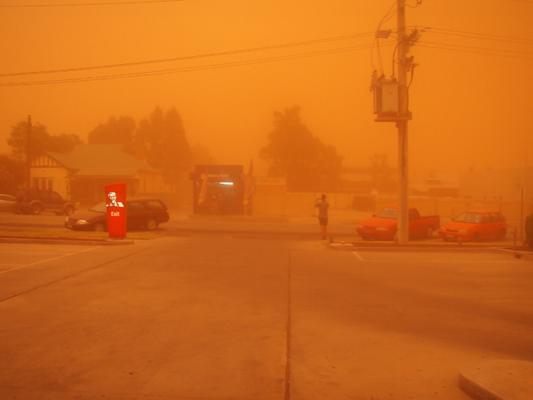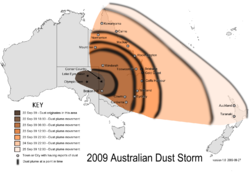The extent of the 2009 Olympic Dam radioactive laced dust storm
Sydney Harbour Bridge
Dust storm over Canberra
Melbourne
The extent of the 2009 Olympic Dam radioactive laced dust storm
This is a small extract from an article written by John Poppins – Canberra Times 15 Nov 2010
BHP Billiton’s uranium quest has too many risks
Thousands of ordinary Australians, including my own family have benefited from BHP Billiton’s mining success. However, like increasing numbers of BHP Billiton shareholders, we are troubled by the long-term effects of some aspects of its mining projects.
These include the Olympic Dam uranium/copper mine in South Australia, the proposed Yeelirrie uranium mine in Western Australia, mining coal directly beneath the rivers which provide a significant portion of Sydney’s diminishing water supply, the increasing number of worker fatalities at BHP Billiton operations, and the withholding of trust funds from traditional owners whose land is being mined.
The experience at Olympic Dam should worry supporters of uranium mining in Western Australia. BHP Billiton uses 37 million litres of water daily at Olympic Dam, for which the company pays nothing. The water is taken from the Great Artesian Basin, and its unsustainable extraction has adversely affected numerous Mound Springs ? precious isolated oases, some of which are host to unique flora and fauna.
The tailings contain finely ground long-lived radioactive materials in a toxic, acidic soup with a seasoning of other heavy metals. They are responsible for large numbers of bird deaths ? more than 100 bird deaths were recorded in a four-day survey in 2004. Only constant watering prevents the radioactive dust being blown across Australia.
Closer to Adelaide we had the following comment made by Mark Parnell MLC :
The Terramin Angus mine near Strathalbyn was required to double line the whole of its tailings pond. As I will explain to members shortly, the Olympic Dam tailings ponds are not even single lined. In fact, they are not even half lined; in fact just 4 per cent of the tailings ponds at Olympic Dam will be lined. So, why does a wealthy company like BHP Billiton expect lower standards and less stringent requirements for the Olympic Dam mine expansion than current industry standards for a mine at Strathalbyn? How can anyone—the Premier, the opposition or BHP Billiton—themselves claim that the waste management at Olympic Dam goes anywhere near being world’s best practice when it is not even South Australian best practice, let alone Australian best practice?
To summarise radioactive waste (tailings) from uranium mines is hazardous to most forms of life and the environment:
Marie Curie observed, 85 percent of the radioactivity in the ore remains behind in that crushed rock. How long will it be there? Well, it turns out that the effective half-life of this radioactivity is 80,000 years. That means in 80,000 years there will be half as much radioactivity in these tailings as there is today.
The tailings are left on the surface of the earth ( at whatever location), they are blown by the wind, they are washed by the rain in water systems and continue to spread far and wide.
One can clearly see from the above photographs that no one can escape what mother nature can do when such radioactive contamination is left in the open, and remember these stockpile are extremely high above the surface.
Tailings are sitting there on the surface, they are continually generating radon gas. Radon is about eight times heavier than air, so it stays close to the ground. It’ll travel 1,000 miles in just a few days in a light breeze. And as it drifts along, it deposits on the vegetation and also gets into animals, fish and plants thousands of miles away from where the uranium mining is done. It’s a mechanism for pumping radioactivity into the environment for millennia to come, and this is one of the hidden dangers.



